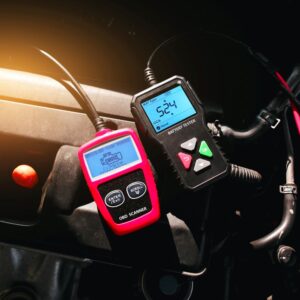Just like you need a checkup at the clinic every year, your vehicle will benefit from going through a diagnostic test every now and then. While these tests aren’t strictly necessary for your vehicle’s regular maintenance, they can still help you catch issues early. Here’s what you need to know about car diagnostic tests and how they help you keep on top of any potential problems in your vehicle:
What Is a Vehicle Diagnostic Test?
A vehicle diagnostic test involves running a digital analysis of a vehicle’s components and various systems. Vehicle diagnostic tests require a certain level of expertise and specialized equipment. That’s why mechanics are more often than not the ones conducting these tests. Vehicle diagnostic tests are usually essential when the check engine light or other warning light illuminates. Some vehicle owners also choose to have vehicle diagnostic tests integrated into their regular maintenance schedule as a form of preventive maintenance.
During a vehicle diagnostic test, a mechanic will typically scan the components and systems to look for engine, transmission, oil tank, and throttle issues. Some scan for even more issues than these depending on the readings and test. Specialized software creates data reports by monitoring the vehicle’s features. The software then collects the data reports so the mechanic can form a proper analysis.
What Parts Are Tested During a Car Diagnosis?
Vehicle diagnostic tests often examine the following components:
- Engine
- Transmission
- Exhaust System
- Brakes
- Fuel injectors
- Ignition Coils
- Airflow and coolant systems
- Throttle
- Powertrain control module (PCM)
In addition to these components, mechanics will also be able to collect the following information:
PCM Issues
The PCM controls many of your vehicle’s systems. It’s basically the vehicle’s brain, so any issues with the PCM will affect your vehicle’s ability to run well. If there are any PCM issues present, you’ll notice a light flashing on your vehicle’s dashboard. There’s a wide range of possible causes behind PCM issues, and a diagnostic test will more often narrow things down and point your mechanic towards the right fix.
Transmission Problems
Your vehicle’s transmission system handles gear shifts, so issues with the transmission can affect your vehicle’s drivability. Vehicle diagnostic tests will help your mechanic catch transmission problems early, which can help you save on repair costs down the road.
Emission Levels
Your vehicle’s emission levels can show how environmentally friendly it is. Most vehicles have to remain under a certain emission level to pass legally mandated emissions tests. A vehicle diagnostic test can tell your mechanic if the exhaust system is damaged, which can lead to dangerous emission spikes.
Idle Speed Stress
Your engine’s idle speed is its RPM while the vehicle isn’t in motion. If the engine’s idle speed is too high, too slow, stalling, or showing signs of stress, it’s an indicator that something might be wrong with the air control valve. A leak in the engine vacuum might also be to blame. Either way, a vehicle diagnosis can inform your mechanic that the idle speed isn’t what it ought to be.
How Often Are Automobile Diagnostic Tests Needed?
Unlike other automotive maintenance tasks, automobile diagnostic tests don’t usually have a set schedule. Many people choose to have them done only when the check engine light illuminates. While this is all well and good, many mechanics recommend having a diagnostics test performed on your vehicle during its regularly scheduled annual service or when you notice performance changes.
Car Diagnostic Test Benefits
There are various benefits to having your mechanic conduct a car diagnostic test annually. These tests can help your mechanic detect problems early and address them before they get worse. This can save you a lot of money in the long run.
For instance, if the diagnostic test reveals an issue with your vehicle’s oxygen sensors, fixing them will improve your vehicle’s fuel efficiency and save you money on gas. Issues found in the engine can also be fixed, which will enhance your vehicle’s overall performance. And finally, if your mechanic finds an issue with the emissions system, they can make sure your vehicle doesn’t fail the emissions test in your state.
How Much Is an Automobile Diagnostic Test?
Automobile diagnostic test costs will vary depending on your vehicle’s make and model and what issues crop up during the test itself. A basic set of tests will run you about $40, and if no further tests are needed, that should be it. Further, more in-depth tests and the subsequent repairs will cost significantly more and can run you up to several hundred dollars depending on how severe the issues are.
Make sure to double-check any fine print when signing a mechanic’s service agreement for an automobile diagnostic test. Some mechanics will claim their diagnostic services are free while adding hidden fees in the contract.
How Long Do Vehicle Diagnostic Tests Take?
When conducted by a good mechanic, vehicle diagnostic tests will typically take less than an hour to finish. The tests are usually much faster than manual troubleshooting.
Can You Conduct a Vehicle Diagnostic Test Yourself?
If you’re techy and familiar with automotive repair, you can attempt to conduct a vehicle diagnostic test yourself. You’ll need a proper scan tool to read the vehicle’s onboard diagnostic (OBD) computer. The OBD computer is connected to the vehicle’s various sensors and will label any issues it finds with a five-character code known as the OBD or OBD-II code. The scan tool you buy will connect to your vehicle via the OBD port and display the error codes on its screen.
To begin the process, turn your vehicle off and insert the scanner’s plug into the OBD port. Insert your vehicle’s key in the ignition and turn it until the power goes on. Make sure not to turn the key enough to start the engine. The scanner’s screen will likely indicate that it’s connected to the OBD computer. You might need to input the vehicle identification number (VIN) or the vehicle make and model before the scanner proceeds.
After that, it’s a matter of finding the active and pending OBD codes. You can input these codes into an online OBD code database to view what they indicate.
If you aren’t too confident with your DIY abilities or if the OBD codes indicate an issue with your vehicle’s critical systems, it’s best to leave the diagnosis and repairs to a professional mechanic.
Any information provided on this Website is for informational purposes only and is not intended to replace consultation with a professional mechanic. The accuracy and timeliness of the information may change from the time of publication.































